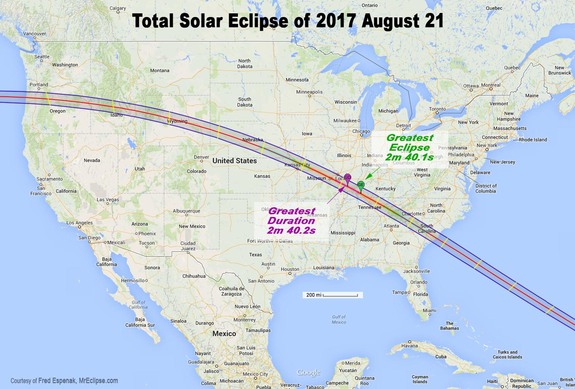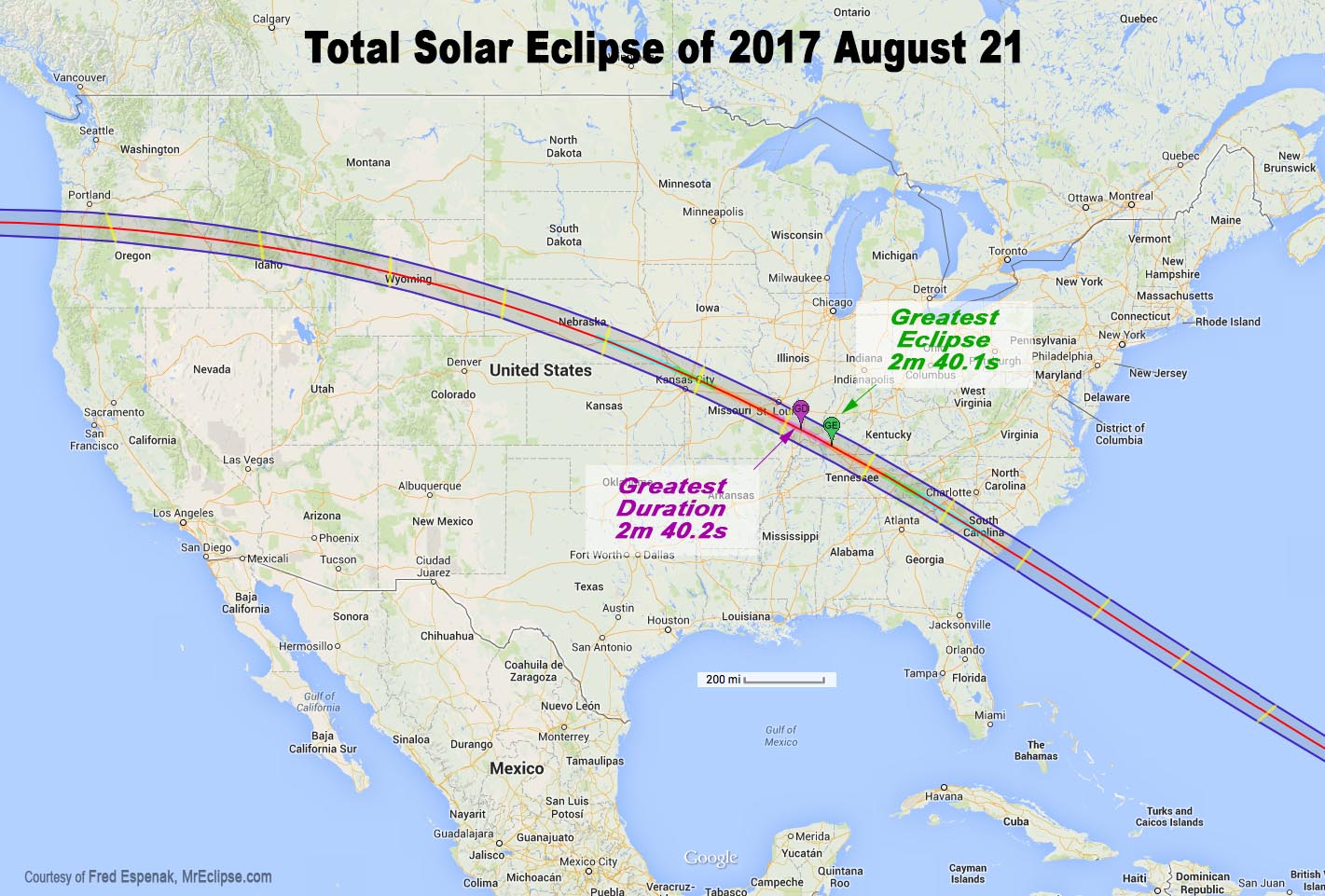Total Solar Eclipse 2017: When, Where and How to See It (Safely)
Mike Wall (space.com)
On Aug. 21, 2017, American skywatchers will be treated to a rare and spectacular celestial show — the first total solar eclipse visible from the continental United States in nearly four decades.
Next year's "Great American Total Solar Eclipse" will darken skies all the way from Oregon to South Carolina, along a stretch of land about 70 miles (113 kilometers) wide. People who descend upon this "path of totality" for the big event are in for an unforgettable experience, said eclipse expert Jay Pasachoff, an astronomer at Williams College in Massachusetts.
"It's a tremendous opportunity," Pasachoff told Space.com. "It's a chance to see the universe change around you." [Solar Eclipses: An Observer's Guide (Infographic)]
A total solar eclipse last darkened soil on the U.S. mainland on Feb. 26, 1979. But August 2017 will mark the first time in 99 years that such an event is "readily available to people from coast to coast," Pasachoff said.


Map showing the path of totality for the Aug. 21, 2017 total solar eclipse.
Credit: Fred Espenak/NASA GSFC
A rare event
The fact that total solar eclipses occur at all is a quirk of cosmic geometry. The moon orbits an average of 239,000 miles (384,600 kilometers) from Earth — just the right distance to seem the same size in the sky as the much-larger sun.But most solar eclipses are of the partial variety, in which the moon appears to take a bite out of the sun's disk. Indeed, two to five solar eclipses occur every year on average; total eclipses happen just once every 18 months or so. (Eclipses are relatively rare because the moon's orbit is inclined about 5 degrees relative to that of Earth. If the two bodies orbited in exactly the same plane, a solar eclipse would occur every month, during the moon's "new" phase.)

How Solar Eclipses Work: When the moon covers up the sun, skywatchers delight in the opportunity to see a rare spectacle. See how solar eclipses occur in this Space.com infographic.
Credit: Karl Tate, SPACE.com Contributor
That path goes from the Oregon coast through Idaho, Wyoming, Nebraska, Kansas, Missouri, Illinois, Kentucky, Tennessee, Georgia, North Carolina and South Carolina. While just 12 million people or so live within the narrow band, perhaps 220 million reside within a day's drive of it, according to Space.com skywatching columnist Joe Rao. [Incredible Solar Eclipse View Shot During Alaska Airlines Flight (Video)]
Pasachoff advises folks to make that drive when the time comes.
"Though the rest of the continental U.S. will have at least a 55 percent partial eclipse, it won’t ever get dark there, and eye-protection filters would have to be used at all times even to know that the eclipse is happening. The dramatic effects occur only for those in the path of totality," Pasachoff said in a statement.
"If you are in that path of totality, you are seeing the main event, but if you are off to the side — even where the sun is 99 percent covered by the moon — it is like going up to the ticket booth of a baseball or football stadium but not going inside," he added.
Pasachoff himself plans to be there. He has observed 63 solar eclipses to date, and not just for fun: The events provide a rare opportunity to study the sun's wispy outer atmosphere, which is called the corona. (The sun's overwhelming brightness usually drowns out the faint corona.)
Temperatures in the corona top 1.8 million degrees Fahrenheit (1 million degrees Celsius), making the region much hotter than the solar surface, which is just 11,000 degrees F (6,000 degrees C) or so. How the corona gets so hot has puzzled scientists for decades, and Pasachoff and his colleagues aim to gather some useful data during the Great American Eclipse.
"How energy is injected into the corona is one of the things we'll be investigating," Pasachoff told Space.com.
Be safe!
You should never look directly at the sun, but there are ways to safely observe an eclipse. See how to safely observe a solar eclipse with this Space.com infographic.
Credit: Karl Tate, SPACE.com Contributor
"Proper eye protection" includes specially made solar filters, eclipse glasses or No. 14 welder's glass. You can also observe the eclipse indirectly, by making a pinhole camera or watching shadows cast by trees. (The gaps between leaves act as natural pinholes.)
To learn more about how to safely observe the sun, check out this Space.com infographic.
Finally, if you miss out on the August 2017 event, don't despair — you'll get another chance seven years later. In 2024, a total solar eclipse will darken the skies above Mexico and Texas, up through the Midwest and northeastern U.S.
